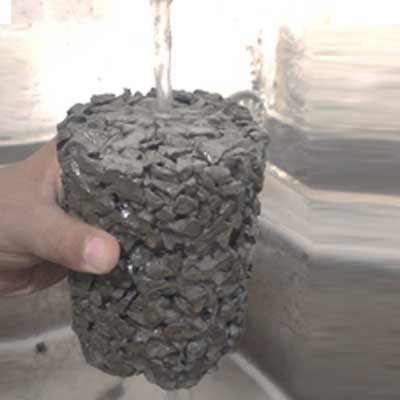For millennia, cities have played an essential role in human evolution. Most economic activities, industry, resources (and their use), waste and pollution creation are concentrated in these areas. The urban population rises as the world’s population grows and cities are developing by building more infrastructure. As a result, traditional construction methods that do not consider environmental concerns have a substantial impact. Among the many difficulties that arise, water management and pollution directly affect people. Water becomes polluted because the natural water cycle is disrupted by the impermeable barrier formed by roads and buildings. Water cannot percolate into the natural soil; instead, it rushes over pavements, generating runoff and polluting the environment. At the same time, this poses a threat to the safety of drivers.
Pavement options
Pavement construction primarily uses standard conventional concrete. The impermeable nature of concrete pavements adds to increased water runoff into drainage systems, overburdening infrastructure and causing excessive flooding in a settled region.
The annual ‘Report Card for America's Infrastructure’ was released by the American Society of Civil Engineers in 2017. Wastewater and stormwater management received a D+ grade, making it a sector of great concern. The investment requirements would approach $ 300 billion over the next 20 years. According to the report, $ 50 billion of that amount would be required to address combined sewer overflow issues. Evidently, the need for various effective stormwater management options is more significant than ever.
Porous pavements have received a lot of attention because they help infiltrate water into the earth, replenish aquifers, and allow water to be preserved for various purposes like agriculture or human use. The majority of these pavements are made of asphalt or cement concrete. Various research works are being carried out worldwide to investigate and enhance such pavements. The application of these materials is primarily determined by the features of the environment in which they are utilised. Porous pavements have a lot of appeal when it comes to stormwater runoff mitigation and decreasing urban heat islands (UHI) because of their open-graded matrix and porous nature.
Pervious concrete (PC) has been used in various pavement applications, including driveways, parking lots, residential streets, alleys and other low-volume roads. PC has been employed in multiple applications, including a surface course, a drainable base course (to provide underground drainage) and a drainable shoulder (for lateral drainage). In recent years, the main focus has been on its use as a surface course for stormwater management.
Properties of PC pavements
PC pavements are unique in that they have an open-graded aggregate structure with high porosity, usually about 20 per cent, to allow freshwater to penetrate the system. Figure 1 shows the water infiltration through a pervious concrete specimen. As a result, the pavement's mechanical performance suffers. Permeable pavements lack a specific design technique that ensures adequate traffic resistance as they are a relatively new material. As a result, they are primarily used in areas with less traffic loading, like parking lots, sidewalks and minor highways.
In PC, the water-cement paste covers and links the constituent mixture particles, forming a porous, linked voids matrix that allows water to drain quickly. Voids typically range from 15 per cent to 25 per cent within the cemented concrete. The average water flow rate per sq m ranges from 81 to 730 l/min/sq m.
The advantages
The use of PC for stormwater management is perhaps its most critical benefit. Stormwater runoff in developed regions (typically caused or exacerbated by an impermeable pavement layer) can contaminate surface and groundwater supplies and contribute to flooding and erosion. PC may impassively capture the ‘initial flush’ of rain (which has a high pollutant concentration) and gently move the trapped water through the soil thanks to its high porosity. The pollutant flowing through is filtered and treated by soil chemistry and biology.
Other advantages of PC include reducing UHI effects on sidewalks (water seeping through the sidewalk can exert a cooling influence through evaporation and convection flow can also contribute to increased pavement cooling), reducing the risk of hydroplaning, water spatter/spray potential, and reduced noise emissions from tires and pavement (noise generated at the tire/road interface is absorbed owing to the open matrix). PC also contributes to the LEED® (Leadership in Energy and Environmental Design) credit grading system required for sustainable building.
Unfortunately, long-term performance data on PC pavements is sparse, yet performance is generally deemed adequate. In Florida, for example, the research found that PC pavements that were 10 to 15 years old were still performing well with little clogging. Field inspections of several projects in freeze zones show good performance and no visible symptoms of freeze-thaw damage.
Hidden limitations
Along with its numerous advantages, there are also drawbacks to using a PC. First and foremost, PCs have always been utilised on low-traffic roads, while several paces are currently exploring their usability in high-traffic areas. Further, PC has material characteristics (primarily lower paste contents and better void contents) and hardened properties (notably density and strength) that are significantly different from conventional concrete. As a result, current quality control/quality assurance methods (e.g., slump, strength, air content) are not applicable in several cases. Also, PC pavement construction necessitates a wide range of specialised techniques. Again, while there are concerns about using PC in places with frequent freeze-thaw cycles, field data from several projects shows no symptoms of freeze-thaw degradation. Sand, mud, plants and other debris can accumulate in the spaces of the PC over time, reducing its porosity and compromising the system’s functionality. As a result, routine maintenance is required to remove surface debris and restore infiltration capacity.
Construction techniques
PC has a variety of unique construction requirements because of its unique material properties. Fixed-form construction is used to lay most PC pavements. A hand-held compaction hammer or vibratory screed can be used for minor jobs. In contrast, a low-frequency vibrating screed is employed for larger projects. A steel roller is used to achieve the necessary level of consolidation. Owing to the porous nature of the mix and the lack of water, PC must be brought and installed as rapidly as feasible.
PC pavements are not finished the same way as traditional pavements. An open surface is achieved owing to the consolidation process’s completed surface. Trowels and other traditional concrete finishing techniques are not used. Jointing is frequently used to control the spread of random cracks. The joints are typically formed to a depth of 1/4th to 1/3rd the block thickness (using a specially developed compacting roller-jointer).
The concrete must be cured after it has been bonded. This is done with a plastic sheet (usually 0.15 mm thick) that covers the entire exposed area. The plastic sheeting should be applied no later than 20 minutes after the concrete has been placed and compacted. It should remain for at least seven days (longer times may be needed depending on placement weather conditions or if supplementary building materials are used in the mix). Liquid membrane curing chemicals are rarely utilised as they only prevent surface moisture loss and affect PC matrix evaporation.
Future needs
PC usage has risen dramatically in recent years, owing to its reputation as an environmentally benign and long-lasting device. PC usage has various advantages, the most important of which is the efficient management of stormwater runoff. The PC pavement may lower toxins in streams, recharge groundwater sources, minimise heat island effects, and reduce pavement-tire noise emissions. There are a few areas where more research is needed to improve or expand its capabilities.
That said, continuous monitoring of PC performance to document long-term performance trends is required. This will also help determine its viability for other applications, such as overlays. This is linked by assessing the feasibility of current structural design methodologies to create intelligent designs, particularly PC fatigue behaviour. Finally, testing and evaluating need to be explored, as present test methods for conventional concrete are not universally relevant to pervious concrete.
About the authors:
Shuddhashil Ghosh is a PhD Scholar, Department of Civil Engineering, at the Indian Institute of Technology - Indore.
Dr Priyansh Singh is an Assistant Professor, Department of Civil Engineering, at the Indian Institute of Technology - Indore.




















